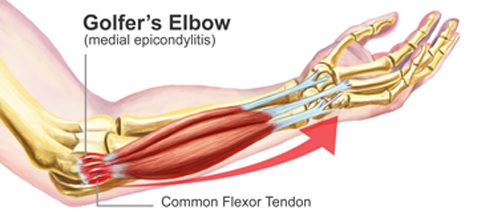Sports Injuries
Golfer’s Elbow
What Is Golfer’s Elbow?
Golfer’s elbow (medial epicondylitis) causes pain and inflammation in the tendons that connect the forearm to the elbow. The pain centers on the bony bump on the inside of your elbow and may radiate into the forearm. It can usually be treated effectively with rest.
Golfer’s elbow is usually caused by overusing the muscles in the forearm that allow you to grip, rotate your arm, and flex your wrist. Repetitive flexing, gripping, or swinging can cause pulls or tiny tears in the tendons.
Care for Bumps, Bruises, Sprains, and Strains
Despite the name, this condition doesn’t just affect golfers. Any repetitive hand, wrist, or forearm motions can lead to golfer’s elbow. Risky sports include tennis, bowling, and baseball — in fact, it’s sometimes called pitcher’s elbow. People may also get it from using tools like screwdrivers and hammers, raking, or painting.
Golfer’s elbow is not as well known as its cousin, tennis elbow. Both are forms of elbow tendinitis. The difference is that tennis elbow stems from damage to tendons on the outside of the elbow, while golfer’s elbow is caused by tendons on the inside. Golfer’s elbow is also less common.


